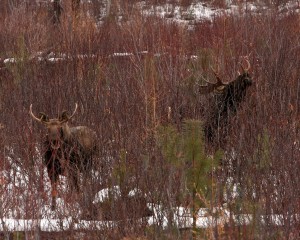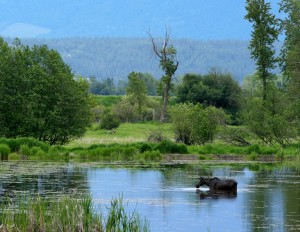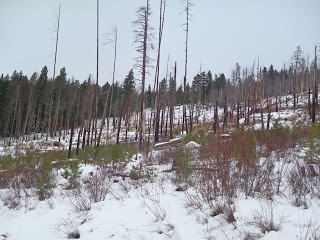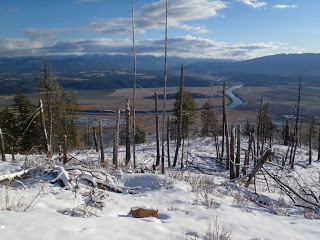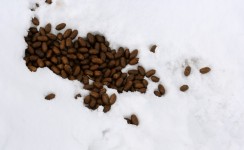Moose are like kids in a candy store when in a big patch of willows–they can’t eat enough of their favorite food. During the winter, willow is their main food along with birch and aspen twigs and bark. How many willow twigs does a 700- to 800- pound moose eat? About 40 to 50 pounds a day!
In order to support this type of diet, moose need large areas of shrubby browse, like willows. Shrubby browse grows profusely in the years following fires, logging and other forest disturbances. The Myrtle Creek fire several years ago created prime moose habitat that is now teeming with moose. Earlier this winter I counted 17 moose in the burn area of Myrtle Creek; compare that to the one set of moose tracks I saw on the Smith Creek road through older timber stands.
In addition to shrubby browse, moose need protective cover to escape the snow and heat. Moose are built to tromp through snow with their long legs and huge feet that can be splayed to act like snowshoes. Powdery snow isn’t a problem for moose if it is less than five feet deep, but wet snow requires more energy. Just like when snowshoeing, powdery snow is easier than wet, heavy snow. When wet snow exceeds two feet, a moose will head for heavy timber or lower elevations where there is less snow.
Moose will also head to heavy timber or north-facing slopes when they need to cool down–even in winter. Their thick hide and dense hair are meant to protect them from the cold, so temperatures above 23 degrees Fahrenheit in the winter can cause heat stress. In the summer, they head to water to cool down, often munching on aquatic plants at the same time. They are excellent swimmers as a result of their long legs.
Not only do their long legs help them swim, wade through snow, maneuver over downed trees and trudge through mud, but they also enable them to run fast. Moose can run at 35 mph over short distances and can trot steadily at 20 mph.
Moose have keen senses to keep them alert to any intruders in their willow patch. Their large ears can be moved independently, which allows them to determine sound direction and contributes to their extremely sensitive hearing. Not only do their ears move independently, but their eyes also do, allowing them to see in two directions at once. If they can’t see or hear an intruder, they probably will smell them. The large nostrils on their bulbous nose facilitate an excellent sense of smell.
While the moose around north Idaho may seem large, they are the smallest of all moose subspecies. There are four subspecies of moose: Alaskan, northwestern, eastern and Shiras. Shiras moose inhabit the Rocky Mountains from southern British Columbia south to Utah and Colorado. Shiras bull moose weigh 800- to 1,000-pounds with antlers in the 45-inch range, while Alaskan moose (the largest subspecies) weigh up to 1,400 pounds with antlers up to 80 inches across. Despite being the smallest moose, Shiras moose are the largest deer species in north Idaho and the biggest fan of willow twigs.

